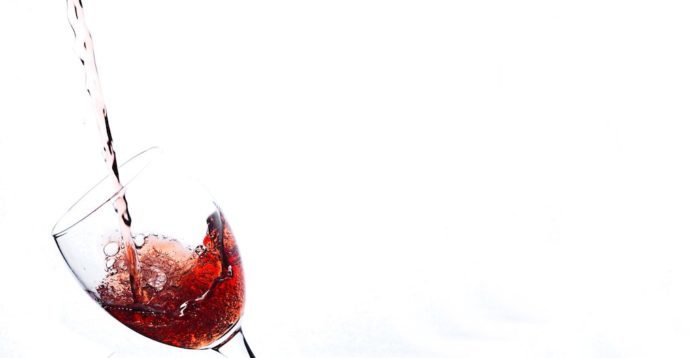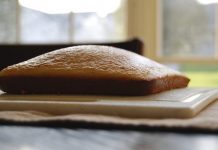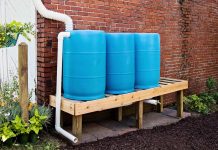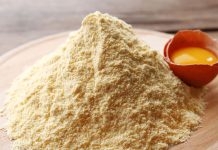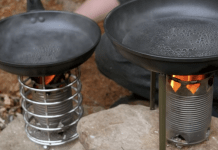If you stumble across a patch of wild black raspberries in the summertime, you’re in for a real treat. They look like a cross between a raspberry and a blackberry, but they have a taste that’s all their own. They often ripen over a long season, and which can make it difficult to pick enough at any given time for preserving. A small batch of black raspberry wine only takes a few handfuls for a full flavored summer fruit wine.
When I first started making fruit wines, I’d process just about any fruit I could find through a countertop juicer. The problem is most home juicers aren’t particularly efficient and most of the flavor and juice stays with the pulp.
This year, I learned a new technique when I made a batch of rhubarb wine that doesn’t require a juicer or press of any sort. Simply pack the fruit in sugar, and the sugar will draw the juice; flavor and color out of the fruit all on its own. The fruit sits in sugar for somewhere between 12 hours and 3 days to fully extract the juice.
In the case of black raspberries, this is a real bonus because you can harvest a handful per day for 2-3 days and just add them to the sugar mash. The high sugar concentration helps preserve them while it extracts their juice. For a 1-quart batch micro-batch of black raspberry wine, you’ll need 1-2 cups of black raspberries.
Start by picking as many as you can into the bottom of a quart mason jar.
Muddle the berries in with sugar, and continue adding berries if necessary over the next day or two. A single gallon batch of fruit wine usually requires 2-3 pounds of sugar, and this one-quart batch of black raspberry wine calls for 3/4 pound. That’s about 1 1/2 cups of granulated sugar.
With wet fruits, like peaches for a peach wine, the sugar/fruit mash will become liquid almost instantly. Black raspberries are quite dry, and they’ll form more or less a paste when muddled with the sugar.
At this point, you have fruit and sugar in a mason jar fermentation vessel. All you need now is an acid source, a tannin source, water, and a little yeast. Those can be added right to the jar.
The wine is going to be fermented right in the jar using a mason jar fermentation kit. These kits are more commonly used to make homemade sauerkraut and other fermented vegetables, but they’re also quite convenient for brewing small-batch wines and meads. That means you won’t have to buy any specialized winemaking equipment, and you can use more general-purpose fermentation tools to get the job done.
Mason jars are also much easier to clean than a traditional wine fermentation vessel. The wide mouth means you can get a hand in the jar and clean out any remaining fruit pulp or yeast sediment easily. When you’re making floral wines, like this dandelion wine, the flower petals can be nearly impossible to clean out of a narrow neck fermenter.
Winemakers often use specialized winemaking additives like acid and tannin powders; to achieve the right balance in a wine. We’re just making a small batch here, and there’s no reason to buy a whole bottle of something when you’re only going to need a pinch. If you’re planning on getting into brewing in general; go ahead and invest in winemaking additives. For everyone else, the acid can come from a bit of lemon juice and the tannin comes from either black tea or the leaves of a currant or grape bush.
Yeast, on the other hand, is a different story.
While you can technically use wild yeast or baking yeast, it’s a horrible idea. Much of the flavor in a wine comes from the yeast and different strains of yeast will produce dramatically different flavors. Bread yeast produces a brew that tastes surprisingly like bread and is often undrinkable.
I usually use a strain of wine yeast called Premier Blanc. It’s a safe bet that rarely fails to produce a great wine, even for new winemakers.
Black Raspberry Wine
Ingredients:
- 1-2 Cups Black Raspberries
- 1 1/2 Cups Sugar, granulated
- 1 Tbsp Lemon Juice
- 2 Tbsp Strongly Brewed Black Tea (or 2-3 currant or grape leaves)
- Premier Blanc Wine Yeast
- Water (Chlorine Free)
Instructions:
- Add the black raspberries directly into the bottom of a 1-quart wide mouth mason jar.
- Top with sugar, and muddle with a spoon.
- Allow the sugar and fruit to sit for at least 3 hours or up to 3 days as you add more fruit from a small black raspberry patch.
- Add in lemon juice and a tannin source. The tannin source can either be strongly brewed black tea or a few grape or currant leaves. If you’re using black tea, add the prepared tea (not the tea leaves or tea bag).
- Fill the jar about 2/3 full with water.
- In a separate container, hydrate the wine yeast with a small amount of water.
- Allow the wine yeast to bloom for at least 5 minutes before adding it into the wine mixture. This is important because adding it into the wine before it’s rehydrated can shock the yeast.
- Pour the hydrated yeast into the wine, and then add more water to fill the mason jar to within 1 inch of the top.
- Seal the mason jar with a mason jar fermentation kit, and allow the wine to ferment at room temperature for 4 to 6 weeks. If material bubbles up into the water lock; remove the lid and clean it out and then put it back on.
- After 4 to 6 weeks, all fermentation activity should have stopped. If it’s still occasionally bubbling; give it more time.
- Carefully pour the finished wine into another mason jar; leaving any sediment behind. A fine mesh strainer is helpful for removing any floating fruit.
- Bottle in a simple Grolsch flip-top bottle, or simply cap the mason jar with a canning lid and give the wine at least 2 weeks to mature before drinking.
Are you ready to try this easy to make black raspberry wine? Be sure to pin this for later, too!
Add the black raspberries directly into the bottom of a 1-quart wide mouth mason jar. Top with sugar, and muddle with a spoon.nnAllow the sugar and fruit to sit for at least 3 hours, or up to 3 days as you add more fruit from a small black raspberry patch. Add in lemon juice and a tannin source. The tannin source can either be strongly brewed black tea or a few grape or currant leaves. If you’re using black tea, add the prepared tea (not the tea leaves or tea bag) Fill the jar about 2/3 full with water. In a separate container, hydrate the wine yeast with a small amount of water. Allow the wine yeast to bloom for at least 5 minutes before adding it into the wine mixture. This is important because adding it into the wine before its rehydrated can shock the yeast. Pour the hydrated yeast into the wine, and then add more water to fill the mason jar to within 1 inch of the top. Seal the mason jar with a mason jar fermentation kit, and allow the wine to ferment at room temperature for 4 to 6 weeks. If material bubbles up into the water lock, remove the lid and clean it out and then put it back on. After 4 to 6 weeks, all fermentation activity should have stopped. If it’s still occasionally bubbling, give it more time. Carefully pour the finished wine into another mason jar, leaving any sediment behind. A fine mesh strainer is helpful for removing any floating fruit. Bottle in a simple Grolsch flip-top bottle or simply cap the mason jar with a canning lid and give the wine at least 2 weeks to mature before drinking.
Black Raspberry Wine
Ingredients
- Ingredients:
- 1-2 Cups Black Raspberries
- 1 1/2 Cups Sugar; granulated
- 1 Tbsp Lemon Juice
- 2 Tbsp Strongly Brewed Black Tea (or 2-3 currant or grape leaves)
- Premier Blanc Wine Yeast
- Water (Chlorine Free)
Instructions
Add the black raspberries directly into the bottom of a 1-quart wide mouth mason jar.
Top with sugar and muddle with a spoon.
Allow the sugar and fruit to sit for at least 3 hours, or up to 3 days as you add more fruit from a small black raspberry patch.
Add in lemon juice and a tannin source. The tannin source can either be strongly brewed black tea or a few grape or currant leaves. If you’re using black tea; add the prepared tea (not the tea leaves or tea bag).
Fill the jar about 2/3 full with water.
In a separate container, hydrate the wine yeast with a small amount of water.
Allow the wine yeast to bloom for at least 5 minutes before adding it into the wine mixture. This is important because adding it into the wine before it’s rehydrated can shock the yeast.
Pour the hydrated yeast into the wine, and then add more water to fill the mason jar to within 1 inch of the top.
Seal the mason jar with a mason jar fermentation kit, and allow the wine to ferment at room temperature for 4 to 6 weeks. If material bubbles up into the water lock; remove the lid and clean it out and then put it back on.
After 4 to 6 weeks, all fermentation activity should have stopped. If it’s still occasionally bubbling, give it more time.
Carefully pour the finished wine into another mason jar, leaving any sediment behind. A fine mesh strainer is helpful for removing any floating fruit.
Bottle in a simple flip-top bottle, or simply cap the mason jar with a canning lid and give the wine at least 2 weeks to mature before drinking.



